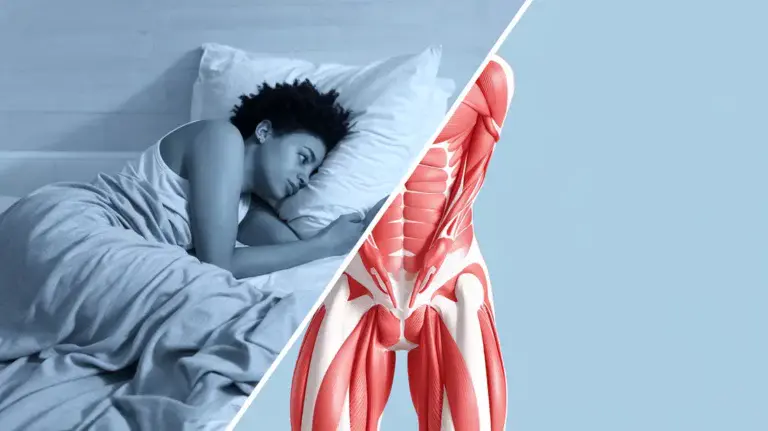Do you feel that familiar twinge when you stand up after hours at your desk?
You’re not alone.
Sitting for more than 6 hours daily significantly increases your risk of hip flexor pain.
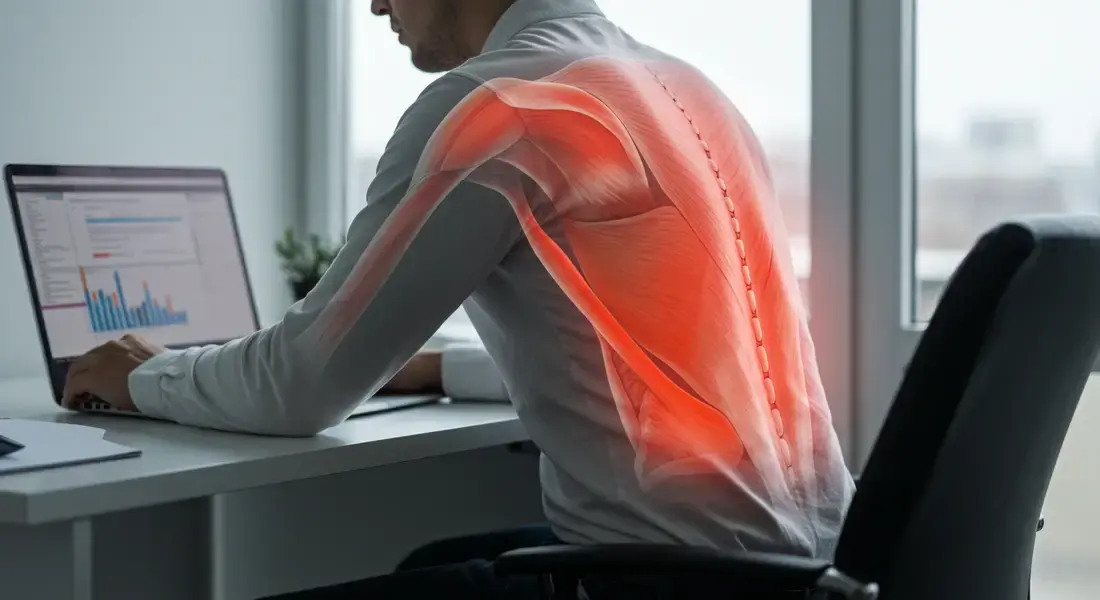
As a desk worker, you’re constantly putting strain on these crucial muscles, but there’s plenty you can do to prevent discomfort and maintain mobility!
This comprehensive guide to hip flexor healthcare for desk workers provides actionable strategies and simple exercises to prevent pain and maintain optimal comfort throughout your workday.
Whether you’re experiencing occasional discomfort or looking to prevent future issues, mastering hip flexor healthcare as a desk worker is essential for long-term well-being and productivity.
Say goodbye to that stiffness and hello to pain-free productivity.
Understanding the Desk Worker’s Hip Flexor Dilemma
Your hip flexors are a group of muscles running from your lower spine and pelvis to your thigh bones.
These powerful muscles help you walk, climb stairs, and bend at the waist.
When you sit for extended periods, they remain in a shortened position, eventually leading to tightness and weakness.
Think of it like keeping your arm bent at the elbow all day – eventually, straightening becomes difficult and uncomfortable.
That’s exactly what happens to your hip flexors during long desk sessions.
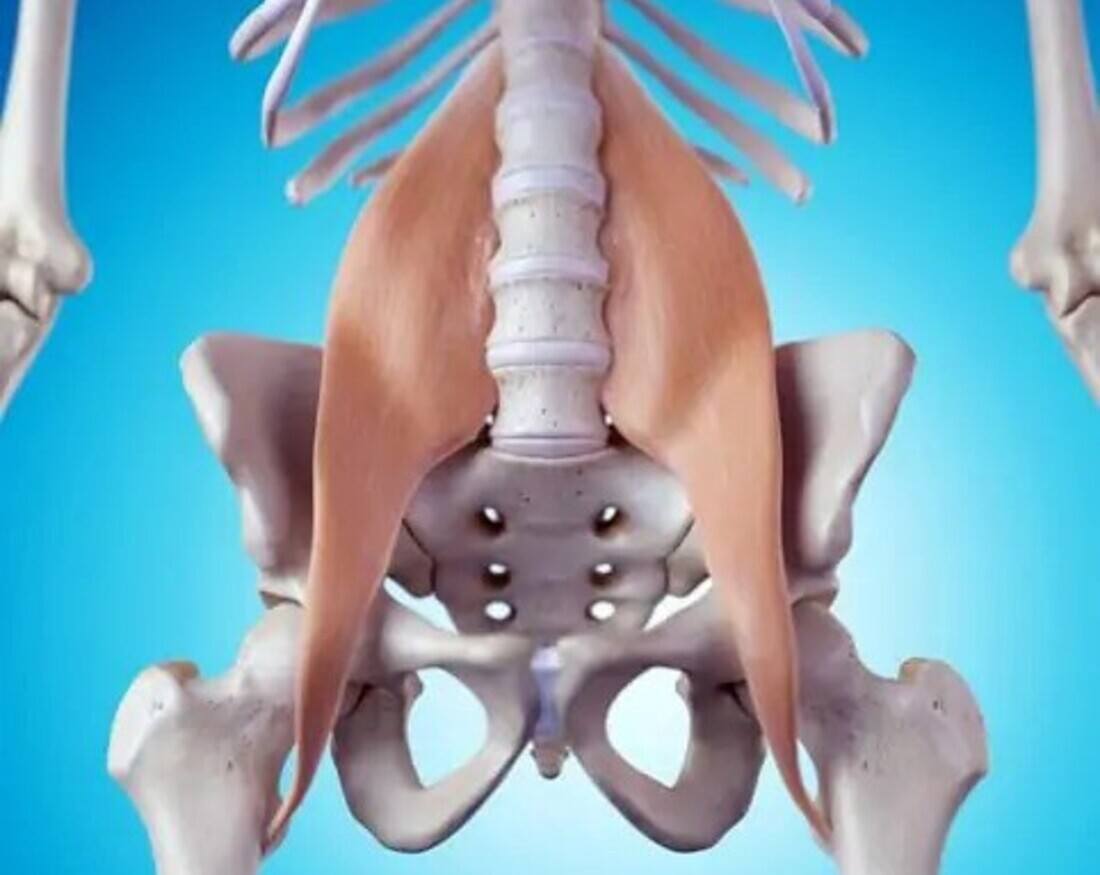
Common Symptoms of Hip Flexor Problems in Desk Workers
- Stiffness in the hips and groin that worsens throughout the workday
- Lower back pain that intensifies after sitting
- Difficulty standing up straight after sitting
- Limited range of motion when walking
- Pain or discomfort when walking or climbing stairs
- Feeling of tightness across the front of the hips
Dr. Megan Richards, physical therapist specializing in workplace ergonomics, explains: “The human body isn’t designed for prolonged sitting. When desk workers remain seated for hours, their hip flexors adapt to this shortened position, creating a cascade of musculoskeletal issues that can extend beyond the hips to affect the entire body.”
Simple Stretches You Can Do At Your Desk
Don’t worry—you don’t need to transform your office into a yoga studio.
These discreet, effective stretches can be done right at your desk to keep your hip flexors happy.
1. Seated Hip Flexor Stretch
How to perform:
- Sit at the edge of your chair with feet flat on the floor
- Extend one leg behind you, keeping your knee bent
- Tuck your pelvis under slightly (posterior pelvic tilt)
- Lean forward gently until you feel a stretch in the front of your hip
- Hold for 20-30 seconds, then switch sides
- Repeat 2-3 times per side
What you’ll need:
- A sturdy chair without wheels
- Enough space to extend one leg behind you
Benefits: This stretch targets the iliopsoas muscle, the primary hip flexor that shortens during prolonged sitting, helping to relieve tension in the lower back.
2. Chair Pigeon Stretch
How to perform:
- Sit tall in your chair
- Cross your right ankle over your left knee
- Keep your right foot flexed to protect your knee
- Gently press down on your right knee or lean forward slightly
- Hold for 20-30 seconds
- Switch sides and repeat
What you’ll need:
- A chair with adequate seat depth
- No armrests (or removable ones)
Benefits: This stretch opens the external rotators of the hip, complementing direct hip flexor stretches for complete hip mobility and preventing stiffness.
3. Seated Figure Four Stretch
How to perform:
- Sit upright with good posture
- Cross one ankle over the opposite thigh, just above the knee
- Maintain a flat foot and flexed ankle
- Gently press down on the bent knee
- For a deeper stretch, hinge forward from the hips while maintaining a straight back
- Hold for 30 seconds, then switch sides
What you’ll need:
- A sturdy chair
- Space to extend your legs
Benefits: This stretch releases tension in the piriformis muscle, which can contribute to hip flexor issues when tight and reduce pain shooting down leg.
4. Lumbar Twists
How to perform:
- Sit sideways in your chair
- Rotate your torso toward the chair back
- Use the chair for leverage to deepen the twist
- Keep both sit bones firmly planted
- Hold for 15-20 seconds
- Repeat on the other side
What you’ll need:
- A chair with a supportive back
Benefits: This stretch relieves tension in the lower back and indirectly helps hip flexor function by improving pelvic alignment and posture.
Ergonomic Adjustments for Hip Flexor Relief – Creating a Supportive Workstation

Your workstation setup plays a crucial role in hip flexor health.
Small adjustments can make a big difference in preventing pain and tightness.
Aim to create a neutral posture that minimizes stress on your hips, back, and neck.
Chair Height
Optimal Setup:
- Feet flat on the floor
- Knees at approximately 90-degree angles
- Thighs parallel to the floor or sloping slightly downward
- 2-3 finger widths of space between the front of the chair and the back of your knees
Why it matters: When your chair is too low, your hips flex more sharply, increasing pressure on the hip flexors. When it’s too high, you may slouch or perch on the edge, creating different strains.
Product Recommendation:
Hbada Ergonomic Office Chairs: This chair features adjustable height, lumbar support, and armrests, allowing you to customize it to your body and maintain proper posture.
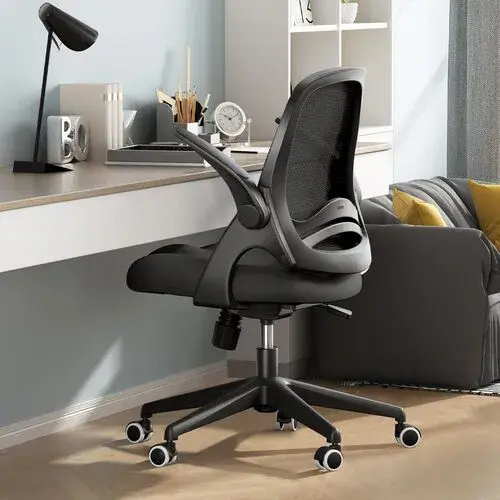
Amazon disclaimer: I may earn with this product.
Lumbar Support
Optimal Setup:
- Chair back supports the natural curve of your lower back
- Small cushion or rolled towel placed at the small of your back if needed
- Back of the chair reclined 10-15 degrees if possible
Why it matters: Proper lumbar support helps maintain neutral pelvic alignment, which directly affects hip flexor position and tension.
Product Recommendation:
LoveHome Memory Foam Lumbar Support Cushion: This adjustable cushion provides targeted support for your lower back, promoting proper spinal alignment and reducing hip flexor strain.

Amazon disclaimer: I may earn with this product.
Monitor Placement
Optimal Setup:
- Top of screen at or slightly below eye level
- Monitor arm’s length away
- Screen centered in front of you
Why it matters: Poor monitor placement leads to forward head posture and rounded shoulders, creating a chain reaction that affects your entire posture, including pelvic position and hip flexor engagement.
Product Recommendation:
VIVO Single Monitor Desk Mount: This adjustable monitor arm allows you to easily position your screen at the optimal height and distance, reducing neck and shoulder strain and promoting better posture.
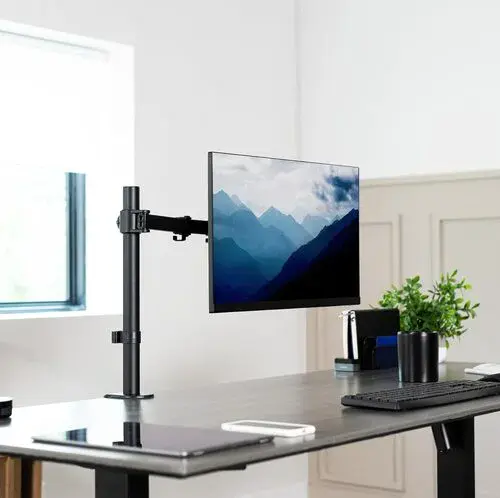
Amazon disclaimer: I may earn with this product.
Keyboard and Mouse Position
Optimal Setup:
- Keyboard and mouse at elbow height
- Wrists neutral, not bent up or down
- Elbows close to body at approximately 90-degree angles
Why it matters: Reaching for an improperly positioned keyboard or mouse affects shoulder position, which influences spine alignment and ultimately pelvic tilt.
Product Recommendation:
Microsoft Sculpt Ergonomic Keyboard and Mouse: This split keyboard and curved mouse promote natural wrist and hand positioning, reducing strain and promoting better posture.
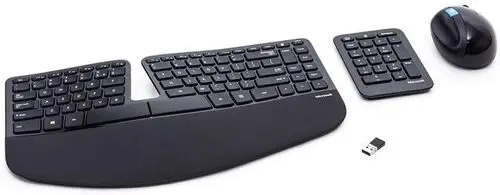
Amazon disclaimer: I may earn with this product.
Footrest
Optimal Setup:
- Use if feet don’t comfortably reach the floor
- Feet flat on the footrest
- Ankles at approximately 90-degree angles
Why it matters: A footrest helps maintain proper lower body alignment, reducing pressure on the hip flexors and promoting better circulation.
Product Recommendation:
Amazon Basics Adjustable Foot Rest: This simple and affordable footrest allows you to elevate your feet and maintain proper lower body alignment.
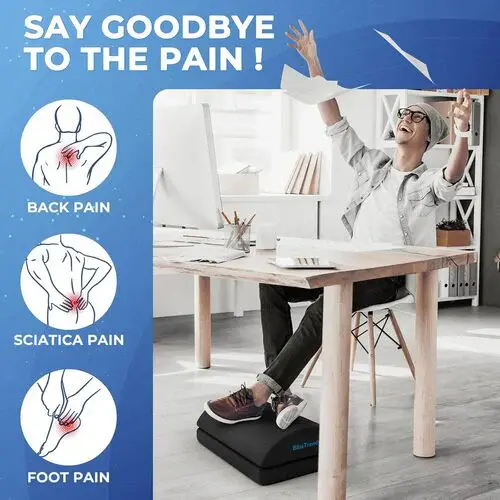
Amazon disclaimer: I may earn with this product.
Movement Breaks – The Key to Hip Flexor Health
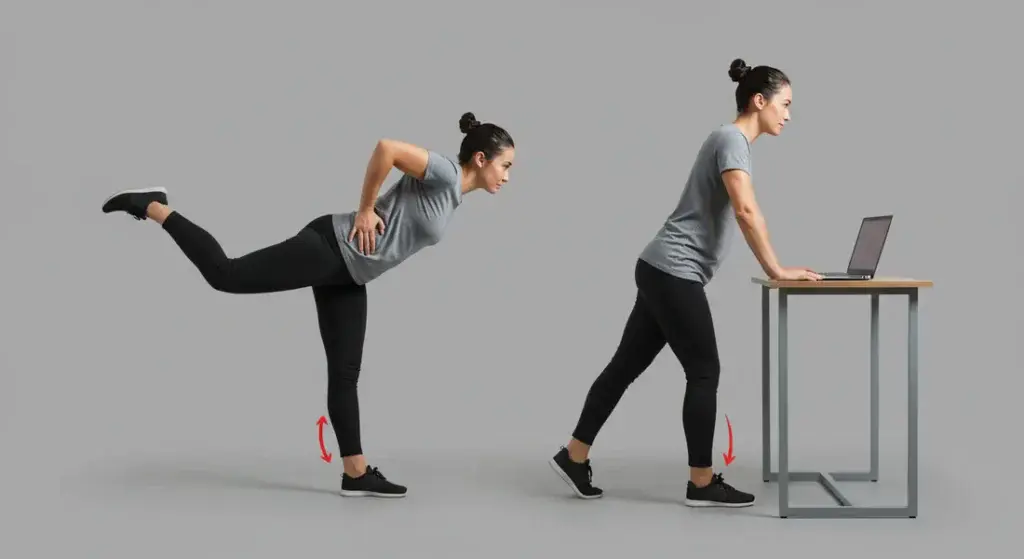
Even the perfect ergonomic setup can’t counteract hours of immobility.
Regular movement breaks are essential for hip flexor health.
Set a timer for every 30-45 minutes as a reminder to move. Even just 1-2 minutes of movement can make a significant difference.
Standing Up and Stretching
- Simply standing and taking 10 deep breaths helps reset your posture
- Add a gentle back bend: place hands on lower back and lean slightly backward
- Try a standing quad stretch: hold onto your desk for stability, bend one knee and bring your foot toward your buttocks
Walking Around the Office
- Take the long route to the bathroom or water cooler
- Use “heel-to-toe” walking for 10-15 steps to activate intrinsic foot muscles
- Add ankle circles while standing during phone calls
- Consider “walking meetings” for discussions that don’t require screen sharing
Desk Exercises
Hip Rotations:
- Stand beside your desk
- Lift one knee to hip height
- Make 5-10 circles with your knee in each direction
- Switch legs and repeat
Chair Squats:
- Stand in front of your chair
- Lower yourself as if sitting down, but just before touching the seat, stand back up
- Repeat 8-10 times
- For added challenge, hold for 3-5 seconds at the bottom position
Strengthening Exercises for Hip Flexor Support
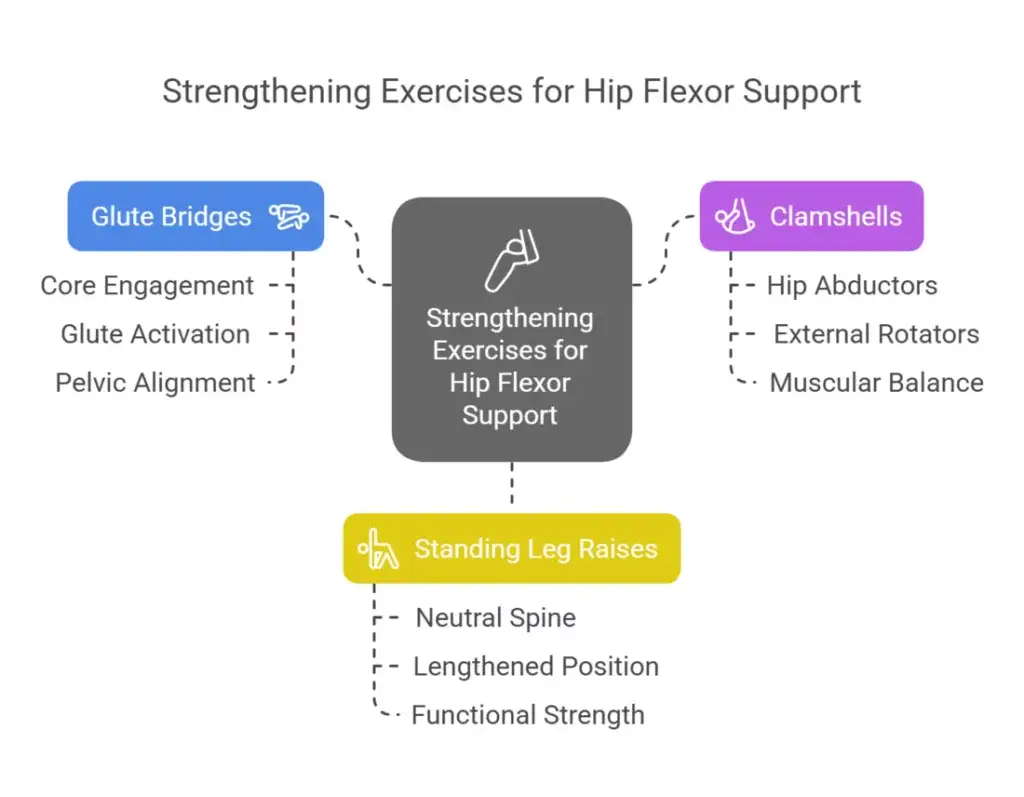
Strong muscles surrounding the hips help maintain proper alignment and support healthy hip flexor function.
Do these exercises at home or during breaks if you have a private office space.
Glute Bridges
How to perform:
- Lie on your back with knees bent and feet flat on the floor
- Engage your core and squeeze your glutes
- Lift your hips toward the ceiling until your body forms a straight line from shoulders to knees
- Hold for 2-3 seconds at the top
- Lower with control
- Repeat 10-15 times for 2-3 sets
Why it helps: Strengthens the glutes and hamstrings, which counterbalance the hip flexors and help maintain pelvic alignment.
Clamshells
How to perform:
- Lie on your side with knees bent at a 45-degree angle
- Keep feet together and hips stacked
- Keep your feet touching while opening your top knee like a clamshell
- Don’t rotate your pelvis or back during the movement
- Repeat 12-15 times per side for 2-3 sets
Why it helps: Strengthens the hip abductors and external rotators, creating better muscular balance around the hip joint.
Standing Leg Raises
How to perform:
- Stand next to a wall or desk for support
- Engage your core and maintain neutral spine
- Slowly raise one leg forward to hip height (or as high as comfortable)
- Lower with control
- Perform 10-12 repetitions, then switch legs
- Complete 2-3 sets
Why it helps: Strengthens the hip flexors in their lengthened position, helping to maintain their functional strength without promoting shortening.
Addressing Common Myths and Misconceptions
Let’s clear up some confusion about hip flexor health for desk workers:
Myth: Stretching alone will fix hip flexor pain.
Reality: While stretching helps relieve symptoms, addressing the root cause requires a comprehensive approach. Stretching tight hip flexors without strengthening the opposing muscles (like glutes) can actually create instability. Think of it as a tug-of-war—both sides need appropriate tension.
Myth: Standing desks are a cure-all for hip flexor problems.
Reality: Standing desks can help reduce sitting time, but standing statically for hours creates its own problems. The key is movement variety—alternating between sitting, standing, and moving throughout the day. Even with a standing desk, take movement breaks and maintain proper posture.
Myth: Hip flexor pain is just a sign of getting old.
Reality: Age isn’t the determining factor for hip flexor health. A 60-year-old with good movement habits can have healthier hip flexors than a sedentary 25-year-old. Hip flexor issues are primarily related to movement patterns and posture, which can be improved at any age.
Myth: You need fancy equipment or a gym membership to fix hip flexor problems.
Reality: Most effective interventions for hip flexor health require nothing more than your body weight, a chair, and consistent habit changes. Simple adjustments to your daily routine can produce significant improvements without special equipment.
Real-Life Success Stories
Sarah’s Journey – From Constant Pain to Comfortable Productivity
Sarah, a 34-year-old software developer, spent 10+ hours daily at her desk. “Every evening, I’d stand up hunched over like an elderly person. The pain in my hips and lower back was unbearable,” she recalls.
After implementing the strategies in this guide—particularly the hourly movement breaks and ergonomic adjustments—Sarah experienced remarkable improvements. “Within three weeks, I noticed I could stand up without that initial pain. After two months, I actually signed up for hiking lessons—something I never thought possible before!”
Mark’s Experience – Preventing Recurring Issues
Mark, a 42-year-old accountant, dealt with recurring hip flexor strains that would sideline him from his weekend tennis matches. “I couldn’t understand why I kept getting injured despite stretching before games,” he explains.
Working with a physical therapist, Mark discovered his desk habits were creating the perfect storm for hip flexor problems. By adding the strengthening exercises from this guide to his routine and adjusting his workstation, Mark hasn’t experienced a hip flexor strain in over a year. “My tennis game has actually improved because I have better mobility and strength in my hips now!”
Addressing Common Questions (FAQs)
What are the best stretches for tight hip flexors?
The most effective stretches target the entire hip flexor group, including the psoas, iliacus, and rectus femoris. The seated hip flexor stretch and lunges with a posterior pelvic tilt are particularly effective. For desk workers, frequency is more important than duration—5-10 second mini-stretches done hourly often yield better results than longer stretches done only occasionally.
Can sitting too much cause hip flexor pain?
Absolutely. Prolonged sitting keeps your hip flexors in a shortened position for extended periods, eventually leading to adaptive shortening of the muscles and connective tissue. This creates tension when you stand or extend your hip, manifesting as discomfort or pain. Additionally, sitting weakens the gluteal muscles that oppose the hip flexors, creating muscular imbalances.
How can I improve my posture while sitting at a desk?
Start by setting up your workstation ergonomically as outlined in this guide. Then, focus on body awareness—set hourly reminders to check your posture. The “sit bone shift” technique can help: slightly shift your weight from one sit bone to the other, then center your weight evenly. This resets your pelvis and spine into better alignment. Also, strengthen your core and back muscles through exercises like planks and bird-dogs to support proper posture.
Are standing desks good for hip flexor health?
Standing desks can be beneficial when used correctly. They allow you to vary your position throughout the day, reducing time spent with hips flexed. However, standing static for hours creates different problems. The ideal approach is a sit-stand workstation where you can alternate positions—perhaps 30-45 minutes sitting followed by 15-20 minutes standing, and regular movement breaks regardless of position.
When should I see a doctor for hip flexor pain?
Consult a healthcare professional if you experience:
- Pain that doesn’t improve with rest and the strategies in this guide
- Pain that wakes you at night or prevents normal activities
- Sharp pain rather than a dull ache
- Pain accompanied by swelling, redness, or heat
- Noticeable weakness in the leg or difficulty bearing weight
- Pain that radiates down the leg
- Any traumatic injury to the hip area
A physical therapist can provide personalized assessment and treatment, while a doctor can rule out underlying conditions like arthritis or labral tears.
Conclusion
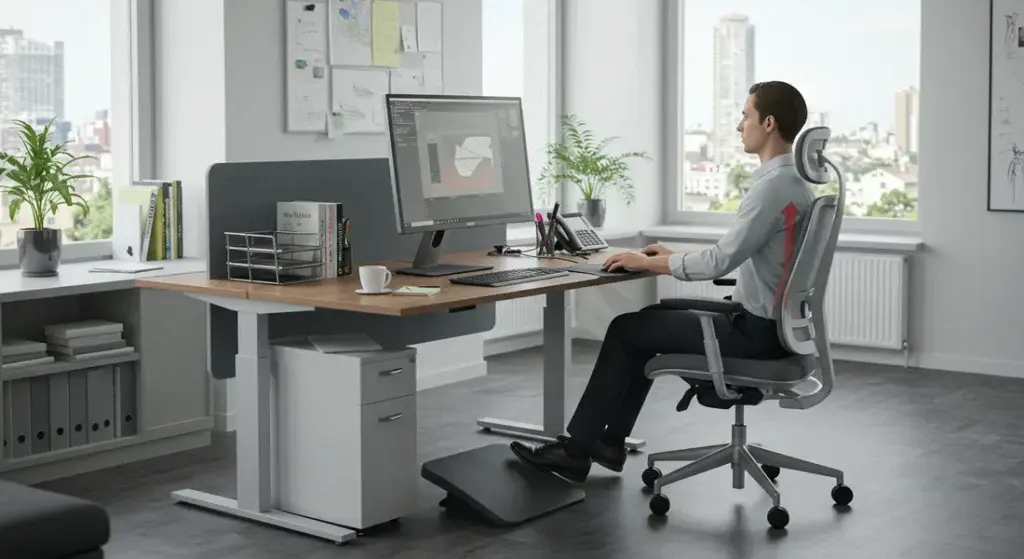
Hip flexor health doesn’t have to be complicated, but it does require consistent attention.
The cumulative effect of small, daily actions makes the biggest difference in preventing hip flexor pain as a desk worker.
Remember these key principles:
- Movement variety is essential—mix sitting, standing, and moving throughout your day
- Both stretching AND strengthening are necessary for balanced hip function
- Ergonomic setup creates the foundation for good posture and hip alignment
- Regular movement breaks prevent adaptive shortening of hip flexors
Start implementing these strategies today—even just one or two changes can begin to make a difference.
Your hip flexors support you through countless movements each day; it’s time to return the favor with proper care and attention.
Don’t wait until pain becomes your constant companion.
Take action now to maintain hip mobility, prevent discomfort, and ensure you can stand tall and move freely at the end of each workday.
[Note: This article provides general information and is not a substitute for professional medical advice. If you’re experiencing persistent or severe pain, please consult a healthcare professional.]



